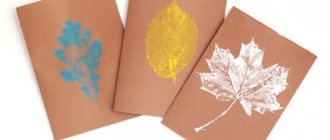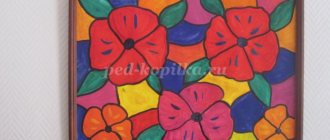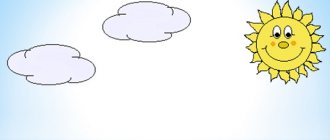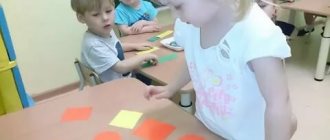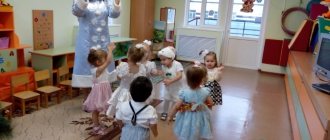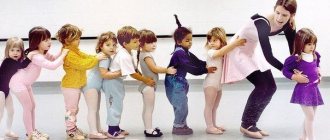Summary of GCD for drawing with young children
Abstract of an educational activity on drawing for young children “Let's feed the Bunny with grass”
Author: Tatyana Nikolaevna Khusainova, teacher, MADOU kindergarten in the village of Kigbaevo, Sarapul district, Udmurt Republic.
Dear colleagues, I would like to bring to your attention a summary of direct educational activities on non-traditional drawing techniques (drawing with palms) for young children.
This material will be useful for teachers of early age groups and parents. Goal: To familiarize children with the techniques of non-traditional drawing techniques (painting with palms) Objectives: 1. Create a positive atmosphere in the group. 2. Teach children to draw with their palms. 3. Develop interest and a positive attitude towards drawing. Materials: Diluted green gouache, Whatman paper, bunny toy, water, napkins, oilcloth.
Progress of the NOD:
Educator:
“The bunny has long ears, They stick out from the bushes.
He jumps and gallops, making his bunnies happy.” A toy bunny appears Teacher:
Guys, look who came to visit us?
That's right, a bunny came to visit us. But for some reason he is very sad. Let's ask him why he is sad? Bunny:
Guys, all winter I ate only bark from trees and twigs.
And I really want to chew some fresh grass. But she still doesn’t show up. Educator:
How can I help the bunny?
You need to draw the grass correctly. But we don't have brushes. Can we draw grass with our palms? (Yes) What color will we paint the grass? (Green) To cheer up the bunny, let's draw him some grass so he can eat it. The children come to the table where there is a large Whatman paper. Educator:
To draw grass, you need to dip your palm in green paint.
Then we place our palm on the sheet. Let's try. This is how much grass we drew for the bunny. Guys, say: “Eat bunny.” Children:
“Eat bunny.”
Bunny:
Thank you guys, what delicious grass, juicy, green.
And now I want to play with you. Game: "Bunny". Bunny, stomp your foot, Like this, stomp your foot, Gray, stomp your foot! That's it, stomp your foot! Children, standing in a circle, stomp their feet, keeping their hands on their belts.
Zainka, clap your hands, Gray, clap your hands!
Children clap their hands
Zainka, turn around, Gray, turn around!
That's it, turn around, That's it, turn around! Children turn 1-2 times, keep their hands on their belts.
Little Bunny, dance, Just like that, dance, Gray, dance!
That's it, dance! Children jump on two legs, whoever can,
Zainka, bow, Gray, bow!
That's it, bow down, That's it, bow down! Children bow, spreading their arms to the sides. Bunny:
Thank you guys, I have to go to my bunnies.
Goodbye. The bunny says goodbye to the guys and runs away.
Result:
What did we draw? (Weed) For whom? (For the bunny) What did we draw with? (Palms)
We recommend watching:
Advice for parents of young artists Cats. Drawing lesson for children Application for March 8th for the senior group of kindergarten Summary of an integrated lesson in drawing and manual labor for 3rd grade of special (correctional) school
Similar articles:
How to develop your child's creativity
Fine arts lesson for the senior group
Monotype in kindergarten
Non-traditional drawing techniques in preschool educational institutions
Non-traditional drawing technique in kindergarten. Passepartout
Notes on finger painting in the second group of early age “Rain, drip, drip, drip”
Notes on finger painting in the second group of early age “Rain, drip, drip, drip”
Topic : “Rain: drip-drip-drip”
Target:
teach children to draw rain in an unconventional way of drawing
-
with their fingers.
Tasks:
1) educational: teach children to draw dots and spots with their fingers, depicting rain.
2) developmental: to form in children a cognitive interest in nature, to promote the development of creative abilities and communication skills; development of fine motor skills.
3) educational: instilling accuracy when doing work; help create a joyful emotional mood in children;
Equipment:
sheets of white paper with images of clouds, A5 format, blue gouache paints; wet wipes, an image of rain, variable samples to explain drawing techniques, an umbrella, a guest - Katya doll; oilcloths for drawing, musical accompaniment.
Preliminary work:
Watching the rain, raindrops, clouds in the sky, reading nursery rhymes about rain.
Progress of the lesson
Educator: Guys, who came to visit us? (Doll)
Educator: Guys, meet me, this is the Katya doll. Look what our guest has in her hands? (Umbrella)
Educator: But for some reason Katya is very sad. She loves to walk in rainy weather under an umbrella. But the trouble is there is no rain today, that’s why she’s sad.
Educator: - Guys, can we help our guest? (Yes)
Educator: - Don’t be sad Katya, our guys will help you.
Educator: - How can you help Katya’s doll?
Educator: - We can draw rain for our guest, but what does it rain from? (from the cloud)
Educator: That's right, rain is dripping from a cloud.
Educator: Look guys, here’s our cloud, but for some reason it’s not raining. What do we do? And the brushes have disappeared somewhere. How are we going to draw rain?
Educator: - And we will draw with our fingers.
Educator: We need paint to draw rain.
Draw the children's attention to the example:
Educator: Guys, look at how we draw the rain.
Educator: I clench all my fingers into a fist, and leave one index finger, dip my little little finger in blue paint, I don’t get a lot of paint, and carefully put my finger on the piece of paper and it turns out to be a drop of rain.
Educator: Now guys, let’s go to their tables.
Educator: Guys, our fingers are tired, and so that they can draw well, we will play with them.
Finger gymnastics “Rain is knocking on my window”
The rain is knocking on my window (we clench and unclench our palms)
Drip-drip-drip (knock your fingers on the table)
The time of autumn has come (we clench and unclench our palms)
Well, well, well (clap our hands)
Educator: Our fingers have rested and we begin to draw.
Independent work. The teacher approaches each child and helps them draw correctly. The music turns on and the children begin to draw.
Educator: Guys, what did we draw for Katya’s doll? (rain) Did you like the rain we drew for our Katya? (yes) What did we use to draw the rain? (fingers)
Educator: Well done, what a beautiful rain it turned out to be, this one is blue, this one is the biggest, this one has small droplets, this one has big droplets. Thank you guys, you helped a lot.
Drawing in young children as a means of developing creative abilities
Bibliographic description:
Kayurova, A. N. Drawing in young children as a means of developing creative abilities / A. N. Kayurova, V. F. Popova.
— Text: immediate // Current tasks of pedagogy: materials of the I International. scientific conf. (Chita, December 2011). - Chita: Young Scientist Publishing House, 2011. - pp. 88-89. — URL: https://moluch.ru/conf/ped/archive/20/1373/ (access date: 11/21/2021). Many abilities and feelings that nature endows us with, unfortunately, remain underdeveloped and undisclosed, and therefore unrealized in the future life. The issue of harmonious development and creative self-realization is becoming almost the most important issue for modern man. Drawing is one of the most favorite activities of young children. And this age is a very important period in the life of children. It is in preschool childhood that every child is a little explorer, discovering the unfamiliar and amazing world around him with joy and surprise. The more diverse children's activities are, the more successful the child's diversified development is, his potential capabilities and first manifestations of creativity are realized. [1, p. 3]
Fine art is a whole science with its own laws and techniques that need to be studied. This is a special language that you need to learn to speak using color, shape, rhythm, line, texture, movement, and other means of expression. But how can you explain picture language to a small child in a simple way? Drawing and visual arts classes give the child the necessary knowledge that he needs for full development, so that he feels the beauty and harmony of nature, so that he better understands himself and other people, so that he expresses original ideas and fantasies, so that he becomes a happy person. [2, p. 5]
When presenting material, it is important to follow the principle of sequence from simple to complex. After all, the main goal of the teacher is to involve the child in the creative process, to make him feel that he is succeeding. There are no strict frameworks that must be met; attempts to find your own, original solution are valued here. Many children can do interesting work. This is how children liberate themselves and become real creative people. The goal of any drawing lesson is to develop children's creative powers and image skills. Along with analyzing the form of an object and clarifying knowledge about it, the teacher must find a place for the child’s initiative, imagination, and the opportunity for the child to complete the task, relying on his personal experience, knowledge, impressions, and imagination. The combination of learning and creative development requires great tact, so that one side does not suppress the other. In the process of work, it is necessary to help each child develop his individual interpretation of the task and do this carefully, without imposing his decision, while taking into account the children’s capabilities.
The main task of teaching drawing is to help children understand the surrounding reality, develop their powers of observation, cultivate a sense of beauty and teach techniques of depiction; at the same time, the main task of visual activity is carried out - the formation of children’s creative abilities in creating expressive images of various objects using visual means available for a given age. The first stage in the development of children's artistic abilities begins from the moment when visual materials - paper, pencil, paints, crayons - first fall into the child's hand. In the future, as children gain experience and master fine arts skills, new tasks can be set for them. Bright and colorful images evoke strong positive emotions in children. The child enjoys any color of pencil or paint, covering everything with them. But even at a young age, he can already associate color with the image of an object. The use of color helps to express the child’s emotional attitude towards what is being depicted. Thus, the means of expression used by children are quite diverse: color, shape, composition.
In the period from 1 to 3 years, the child rapidly masters speech. Songs, nursery rhymes and fairy tales are the first literary works a child hears. Getting acquainted with the works of poets and writers, oral folk art, imbued with wisdom and kindness, the child learns to be honest, fair and responsive. Children of this age have a well-developed imagination, they get vivid impressions from an emotionally told fairy tale. Children empathize so actively that they even feel like they are participants in the events discussed in a fairy tale or nursery rhyme. Kids will be very enthusiastic to help heroes who need their support: grains for chickens, windows in the little house. Starting classes with a fairy tale, a funny poem or a nursery rhyme, you can emotionally touch the child and turn the lesson into an exciting game. Role-playing and active games, entertaining tasks for the development of thinking also contribute to the creation of a playful mood.[3, p.5] Visual activity is also communication between an adult and a child. By maintaining interest in the activity, you can offer other ways to achieve what you want. For example, if you can’t draw a car, offer to make a car from a construction set. If a child quickly loses interest in an activity, perhaps it is too simple, you should understand the reason and make it more difficult or easier. In order for the child to understand the task and complete it, it is necessary to develop attention and the ability to concentrate, try to attract the child to the logical conclusion of the task.[3, p.5]
In drawing classes, kids learn to hold a brush correctly, draw lines and round objects using a brush, foam rubber and fingers, apply dots and strokes evenly with fingers and foam rubber in a given space, make prints with the palm of their hand and bring them to a certain image; paint over single-color objects, trying not to go beyond the contours, distinguish and name colors (red, blue, green, yellow, white, black). Children aged 2-3 years should practice drawing systematically 1-2 times a week, the duration of the lesson is 5-10 minutes. [3, p.5] Drawing introduces children to the world of beauty, develops creativity (the creative beginning of the individual), forms aesthetic taste, and allows them to feel the harmony of the world around them. Often carries an element of psychotherapy - it calms, distracts, occupies. Drawing encourages children to be creative and teaches them to see the world in living colors. It is important not to miss the opportunities that open up at an early age; it is necessary to develop the child’s ability to perceive the world figuratively and come up with new stories. Thus, with skillful organization of classes and taking into account the psychological and physiological characteristics of children 1-3 years old, drawing can become one of the favorite activities of children.
Having discovered a unique individuality, the child will be able to realize himself more fully in life, in school, in creativity, in communication with others. He will acquire another, additional language that he needs to express his thoughts, feelings and emotions. The acquired knowledge will become the basis for him to become a non-standard personality in the future, capable of action and creation.[2, p. 8]
Literature:
- Davydova G.N. Unconventional drawing techniques in kindergarten. Part 1. – M.: “Publishing house Scriptorium 2003”, 2007. – 80 p.
- Dreznina M.G. Every child is an artist: Teaching preschoolers to draw. – M.: Yuventa Publishing House, 2002. – 200 p.: ill.
- Koldina D.N. Modeling and drawing with children 2-3 years old. Class notes. - M.: MOSAIKA-SYNTHESIS, 2009. - 56 pp.: color. on
Key terms
(automatically generated)
: child, drawing activity, Visual activity, baby, early age, drawing.

